Review of Atom Chips for Absolute Gravity Sensors
Abstract
:1. Introduction
2. Basic Theory of CAGS and Magneto–Optical Trap (MOT)
3. Micro Magnetic Traps Design on Chips
4. Magneto–Optical Trap Realized by Various Atom Chips
5. Material and Fabrication Technologies of Different Atom Chips
6. Package Methods of Atom Chips for CAGSs Application
7. Different CAGSs Realized Using Atom Chips
8. Conclusions
Author Contributions
Funding
Institutional Review Board Statement
Informed Consent Statement
Data Availability Statement
Acknowledgments
Conflicts of Interest
References
- Bong, K.; Holynski, M.; Vovrosh, J.; Bouyer, P.; Condon, G.; Rasel, E.; Schubert, C.; Schleich, W.P.; Roura, A. Taking atom interferometric quantum sensors from the laboratory to real-world applications. Nat. Rev. Phys. 2019, 1, 731–739. [Google Scholar] [CrossRef]
- Rosi, G.; D’Amico, G.; Cacciapuoti, L.; Sorrentino, F.; Prevedelli, M.; Zych, M.; Brukner, C.; Tino, G.M. Quantum test of the equivalence principle for atoms in coherent superposition of internal energy states. Nat. Commun. 2017, 8, 15529. [Google Scholar] [CrossRef]
- Sabulsky, D.O.; Dutta, I.; Hinds, E.A.; Elder, B.; Burrage, C.; Copeland, E.J. Experiment to detect dark energy forces using atom interferometry. Phys. Rev. Lett. 2019, 123, 061102. [Google Scholar] [CrossRef] [PubMed]
- Burrage, C.; Copeland, E.J. Using atom interferometry to detect dark energy. Contemp. Phys. 2016, 57, 164–176. [Google Scholar] [CrossRef]
- Wang, Y.J.; Lu, X.Y.; Qin, C.G.; Tan, Y.J.; Shao, C.G. Modeling gravitational wave detection with atom interferometry. Class. Quant. Grav. 2021, 38, 145025. [Google Scholar] [CrossRef]
- Dimopoulos, S.; Graham, P.W.; Hogan, J.M.; Kasevich, M.A.; Rajendran, S. Gravitational wave detection with atom interferometry. Phys. Lett. B 2009, 678, 37–40. [Google Scholar] [CrossRef]
- Rosi, G.; Cacciapuoti, L.; Sorrentino, F.; Menchetti, M.; Prevedelli, M.; Tino, G.M. Measurement of the gravity-field curvature by atom interferometry. Phys. Rev. Lett. 2015, 114, 013001. [Google Scholar] [CrossRef]
- Mao, D.K.; Deng, X.B.; Luo, H.Q.; Xu, Y.Y.; Zhou, M.K.; Duan, X.C.; Hu, Z.K. A dual-magneto-optical-trap atom gravity gradiometer for determining the Newtonian gravitational constant. Rev. Sci. Instrum. 2021, 92, 053202. [Google Scholar] [CrossRef]
- Sorrentino, F.; Alberti, A.; Ferrari, G.; Ivanov, V.V.; Poli, N.; Schioppo, M.; Tino, G.M. Quantum sensor for atom-surface interactions below 10 μm. Phys. Rev. A 2009, 79, 013409. [Google Scholar] [CrossRef]
- Mohapatra, A.K.; Chaudhuri, S.; Roy, S.; Unnikrishnan, C.S. Experiments on the reflection of cold atoms from magnetic thin films—From atom optics to measurement of short-range forces. Eur. Phys. J. D 2007, 42, 287–298. [Google Scholar] [CrossRef]
- Chang, L.B.; Qin, F.J.; Wu, M.P. Gravity disturbance compensation for inertial navigation system. IEEE Trans. Instrum. Meas. 2019, 68, 3751–3765. [Google Scholar] [CrossRef]
- Wu, L.; Wang, H.B.; Chai, H.; Hsu, H.T.; Wang, Y. Research on the relative positions-constrained pattern matching method for underwater gravity-aided inertial navigation. J. Navig. 2015, 68, 937–950. [Google Scholar] [CrossRef]
- Boukebbab, S.; Boulahlib, M.S. The spatial interactions using the gravity model: Application at the evaluation of transport efficiency at Constantine city, Algeria. Theory Eng. Complex Syst. Dependability 2015, 365, 35–44. [Google Scholar] [CrossRef]
- Thompson, C.A.; Saxberg, K.; Lega, J.; Tong, D.; Brown, H.E. A cumulative gravity model for inter-urban spatial interaction at different scales. J. Transp. Geogr. 2019, 79, 102461. [Google Scholar] [CrossRef]
- Zhu, Y.Q.; Zhan, F.B.; Zhou, J.C.; Liang, W.F.; Xu, Y.M. Gravity measurements and their variations before the 2008 Wenchuan earthquake. B. Seism. Soc. Am. 2010, 100, 2815–2824. [Google Scholar] [CrossRef]
- Zhu, Y.; Liu, F.; You, X.; Liang, W.; Zhao, Y.; Liu, L. Earthquake prediction from China’s mobile gravity data. Geod. Geodyn. 2015, 6, 81–90. [Google Scholar] [CrossRef]
- Xing, L.L.; Wang, L.H.; Hu, M.Z. Determination of mantle upwelling rate beneath Taiyuan basin by using absolute gravity, GPS, groundwater and GLDAS data. J. Appl. Geophys. 2017, 138, 179–184. [Google Scholar] [CrossRef]
- Alonso, I.; Alpigiani, C.; Altschul, B.; Araujo, H.; Arduini, G.; Arlt, J.; Badurina, L.; Balaz, A.; Bandarupally, S.; Barish, B.C.; et al. Cold atoms in space: Community workshop summary and proposed road-map. Epj Quantum Technol. 2022, 9, 30. [Google Scholar] [CrossRef]
- Freier, C.; Hauth, M.; Schkolnik, V.; Leykauf, B.; Schilling, M.; Wziontek, H.; Scherneck, H.G.; Muller, J.; Peters, A. Mobile quantum gravity sensor with unprecedented stability. In Proceedings of the 8th Symposium on Frequency Standards and Metrology 2015, Potsdam, Germany, 12–16 October 2015; Volume 723. [Google Scholar] [CrossRef]
- Bidel, Y.; Carraz, O.; Charrière, R.; Cadoret, M.; Zahzam, N.; Bresson, A. Compact cold atom gravimeter for field applications. Appl. Phys. Lett. 2013, 102, 144107. [Google Scholar] [CrossRef]
- Matsko, A.B.; Yu, N.; Maleki, L. Gravity field measurements using cold atoms with direct optical readout. Phys. Rev. A 2003, 67, 043819. [Google Scholar] [CrossRef]
- Hu, Z.K.; Duan, X.C.; Zhou, M.K.; Chen, L.L. High sensitivity gravity measurements with cold atom interferometry. In Proceedings of the 2014 Conference on Lasers and Electro-Optics (CLEO)—Laser Science to Photonic Applications, San Jose, CA, USA, 8–13 June 2014. [Google Scholar] [CrossRef]
- Kasevich, M.; Chu, S. Atomic interferometry using stimulated raman transitions. Phys. Rev. Lett. 1991, 67, 181–184. [Google Scholar] [CrossRef]
- Wang, S.K.; Zhao, Y.; Zhuang, W.; Li, T.C.; Wu, S.Q.; Feng, J.Y.; Li, C.J. Shift evaluation of the atomic gravimeter NIM-AGRb-1 and its comparison with FG5X. Metrologia 2018, 55, 360–365. [Google Scholar] [CrossRef]
- Gillot, P.; Francis, O.; Landragin, A.; Dos Santos, F.P.; Merlet, S. Stability comparison of two absolute gravimeters: Optical versus atomic interferometers. Metrologia 2014, 51, L15–L17. [Google Scholar] [CrossRef]
- Karcher, R.; Imanaliev, A.; Merlet, S.; Santos, F.P.D. Improving the accuracy of atom interferometers with ultracold sources. New J. Phys. 2018, 20, 113041. [Google Scholar] [CrossRef]
- Hu, Z.-K.; Sun, B.-L.; Duan, X.-C.; Zhou, M.-K.; Chen, L.-L.; Zhan, S.; Zhang, Q.-Z.; Luo, J. Demonstration of an ultrahigh-sensitivity atom-interferometry absolute gravimeter. Phys. Rev. A 2013, 88, 043610. [Google Scholar] [CrossRef]
- Wang, K.N.; Xu, H.; Zhou, Y.; Xu, Y.P.; Song, W.; Tang, H.Z.; Wang, Q.W.; Zhu, D.; Weng, K.X.; Wang, H.L.; et al. Research on rapid surveying and mapping of outfield absolute gravity based on vehicle-mounted atomic gravimeter. Acta Phys. Sin. 2022, 71, 159101. [Google Scholar] [CrossRef]
- Guo, J.; Ma, S.; Zhou, C.; Liu, J.; Wang, B.; Pan, D.; Mao, H. Vibration compensation for a vehicle-mounted atom gravimeter. IEEE Sens. J. 2022, 22, 12939–12946. [Google Scholar] [CrossRef]
- Zhu, D.; Xu, H.; Zhou, Y.; Wu, B.; Cheng, B.; Wang, K.N.; Chen, P.J.; Gao, S.T.; Weng, K.X.; Wang, H.L.; et al. Data processing of shipborne absolute gravity measurement based on extended Kalman filter algorithm. Acta Phys. Sin. 2022, 71, 133702. [Google Scholar] [CrossRef]
- Wu, B.; Zhao, Y.; Zhou, Y.; Yuan, P.; Zhu, D.; Cheng, B.; Wu, L.; Qiao, Z.; Wang, X.; Lin, Q. Improvement of the accuracy of ocean tide model based on the offshore continuous gravity data with atomic gravimeter. ESS Open Arch. 2023, 13, 1–14. [Google Scholar] [CrossRef]
- Bidel, Y.; Zahzam, N.; Bresson, A.; Blanchard, C.; Cadoret, M.; Olesen, A.V.; Forsberg, R. Absolute airborne gravimetry with a cold atom sensor. J. Geod. 2020, 94, 20. [Google Scholar] [CrossRef]
- Bonnin, A.; Bidel, Y.; Bernard, J.; Blanchard, C.; Cadoret, M.; Zahzam, N.; Schwartz, S.; Bresson, A. Marine and Airborne Gravimetry with an Absolute Cold Atom Sensor. In Proceedings of the 2022 IEEE International Symposium on Inertial Sensors and Systems (INERTIAL), Avignon, France, 8–11 May 2022; pp. 1–4. [Google Scholar] [CrossRef]
- Trimeche, A.; Battelier, B.; Becker, D.; Bertoldi, A.; Bouyer, P.; Braxmaier, C.; Charron, E.; Corgier, R.; Cornelius, M.; Douch, K.; et al. Concept study and preliminary design of a cold atom interferometer for space gravity gradiometry. Class. Quant. Grav. 2019, 36, 215004. [Google Scholar] [CrossRef]
- Zahzam, N.; Christophe, B.; Lebat, V.; Hardy, E.; Huynh, P.A.; Marquet, N.; Blanchard, C.; Bidel, Y.; Bresson, A.; Abrykosov, P.; et al. Hybrid electrostatic-atomic accelerometer for future space gravity missions. Remote Sens. 2022, 14, 3273. [Google Scholar] [CrossRef]
- Wu, X.J.; Pagel, Z.; Malek, B.S.; Nguyen, T.H.; Zi, F.; Scheirer, D.S.; Muller, H. Gravity surveys using a mobile atom interferometer. Sci. Adv. 2019, 5, eaax0800. [Google Scholar] [CrossRef]
- Zhang, X.; Zhong, J.; Tang, B.; Chen, X.; Zhu, L.; Huang, P.; Wang, J.; Zhan, M. Compact portable laser system for mobile cold atom gravimeters. Appl. Opt. 2018, 57, 6545–6551. [Google Scholar] [CrossRef]
- Peters, A.; Chung, K.Y.; Chu, S. High-precision gravity measurements using atom interferometry. Metrologia 2001, 38, 25–61. [Google Scholar] [CrossRef]
- Chiow, S.W.; Herrmann, S.; Chu, S.; Muller, H. Noise-immune conjugate large-area atom interferometers. Phys. Rev. Lett. 2009, 103, 050402. [Google Scholar] [CrossRef]
- Biedermann, G.W.; Wu, X.; Deslauriers, L.; Roy, S.; Mahadeswaraswamy, C.; Kasevich, M.A. Testing gravity with cold-atom interferometers. Phys. Rev. A 2015, 91, 033629. [Google Scholar] [CrossRef]
- Gillot, P.; Cheng, B.; Imanaliev, A.; Merlet, S.; Dos Santos, F.P. The LNE-SYRTE cold atom gravimeter. In Proceedings of the 016 European Frequency and Time Forum (EFTF), York, UK, 4–7 April 2016; pp. 1–4. [Google Scholar]
- Xu, Y.Y.; Cui, J.F.; Qi, K.; Chen, L.L.; Deng, X.B.; Luo, Q.; Zhang, H.; Tan, Y.J.; Shao, C.G.; Zhou, M.K.; et al. Evaluation of the transportable atom gravimeter HUST-QG. Metrologia 2022, 59, 055001. [Google Scholar] [CrossRef]
- Folman, R.; Kruger, P.; Schmiedmayer, J.; Denschlag, J.; Henkel, C. Microscopic atom optics: From wires to an atom chip. Adv. At. Mol. Opt. Phy. 2002, 48, 263–356. [Google Scholar]
- Weinstein, J.D.; Libbrecht, K.G. Microscopic magnetic traps for neutral atoms. Phys. Rev. A 1995, 52, 4004–4009. [Google Scholar] [CrossRef]
- Reichel, J.; Hansell, W.; Hansch, T.W. Atomic micromanipulation with magnetic surface traps. Phys. Rev. Lett. 1999, 83, 3398–3401. [Google Scholar] [CrossRef]
- Reichel, J. Microchip traps and Bose–Einstein condensation. Appl. Phys. B 2002, 74, 469–487. [Google Scholar] [CrossRef]
- Hansel, W.; Hommelhoff, P.; Hansch, T.W.; Reichel, J. Bose-Einstein condensation on a microelectronic chip. Nature 2001, 413, 498–501. [Google Scholar] [CrossRef]
- Schkolnik, V.; Hellmig, O.; Wenzlawski, A.; Grosse, J.; Kohfeldt, A.; Doringshoff, K.; Wicht, A.; Windpassinger, P.; Sengstock, K.; Braxmaier, C.; et al. A compact and robust diode laser system for atom interferometry on a sounding rocket. Appl. Phys. B 2016, 122, 217. [Google Scholar] [CrossRef]
- Abend, S.; Gebbe, M.; Gersemann, M.; Ahlers, H.; Muntinga, H.; Giese, E.; Gaaloul, N.; Schubert, C.; Lammerzahl, C.; Ertmer, W.; et al. Atom-chip fountain gravimeter. Phys. Rev. Lett. 2016, 117, 203003. [Google Scholar] [CrossRef]
- McGilligan, J.P.; Moore, K.R.; Dellis, A.; Martinez, G.D.; de Clercq, E.; Griffin, P.F.; Arnold, A.S.; Riis, E.; Boudot, R.; Kitching, J. Laser cooling in a chip-scale platform. Appl. Phys. Lett. 2020, 117, 054001. [Google Scholar] [CrossRef]
- Kasevich, M.; Chu, S. Measurement of the gravitational acceleration of an atom with a light-pulse atom interferometer. Appl. Phys. B-Photo 1992, 54, 321–332. [Google Scholar] [CrossRef]
- Phillips, W.D. Nobel Lecture: Laser cooling and trapping of neutral atoms. Rev. Mod. Phys. 1998, 70, 721–741. [Google Scholar] [CrossRef]
- Raab, E.L.; Prentiss, M.; Cable, A.; Chu, S.; Pritchard, D.E. Trapping of neutral sodium atoms with radiation pressure. Phys. Rev. Lett. 1987, 59, 2631–2634. [Google Scholar] [CrossRef]
- Zhang, H.K.; Wang, Y.N.; Zhu, L.X.; Li, Q.X.; Xu, D.Y.; Zhang, X.; Yan, S.H.; Yang, J. Increasing the length of free-falling path with homogeneous bias field for compact cold atom interferometers by configuring MOT coils. AIP Adv. 2020, 10, 095134. [Google Scholar] [CrossRef]
- Wang, X.L.; Cheng, B.; Wu, B.; Wang, Z.Y.; Lin, Q. A simplified cold atom source for 3-D MOT loading. Chin. Phys. Lett. 2011, 28, 053701. [Google Scholar] [CrossRef]
- Lin, Y.W.; Chou, H.C.; Dwivedi, P.P.; Chen, Y.C.; Yu, I.A. Using a pair of rectangular coils in the MOT for the production of cold atom clouds with large optical density. Opt. Express 2008, 16, 3753–3761. [Google Scholar] [CrossRef]
- Fu, Z.J.; Wu, B.; Cheng, B.; Zhou, Y.; Weng, K.X.; Zhu, D.; Wang, Z.Y.; Lin, Q. A new type of compact gravimeter for long-term absolute gravity monitoring. Metrologia 2019, 56, 025001. [Google Scholar] [CrossRef]
- Devani, D.; Maddox, S.; Renshaw, R.; Cox, N.; Sweeney, H.; Cross, T.; Holynski, M.; Nolli, R.; Winch, J.; Bongs, K.; et al. Gravity sensing: Cold atom trap onboard a 6U CubeSat. CEAS Space J. 2020, 12, 539–549. [Google Scholar] [CrossRef]
- Brugger, K.; Calarco, T.; Cassettari, D.; Folman, R.; Haase, A.; Hessmo, B.; Kruger, P.; Maier, T.; Schmiedmayer, J. Nanofabricated atom optics: Atom chips. J. Mod. Opt. 2000, 47, 2789–2809. [Google Scholar] [CrossRef]
- Schumm, T.; Esteve, J.; Figl, C.; Trebbia, J.B.; Aussibal, C.; Nguyen, H.; Mailly, D.; Bouchoule, I.; Westbrook, C.I.; Aspect, A. Atom chips in the real world: The effects of wire corrugation. Eur. Phys. J. D 2005, 32, 171–180. [Google Scholar] [CrossRef]
- Barb, I.; Gerritsma, R.; Xing, Y.T.; Goedkoop, J.B.; Spreeuw, R.J.C. Creating Ioffe-Pritchard micro-traps from permanent magnetic film with in-plane magnetization. Eur. Phys. J. D 2005, 35, 75–79. [Google Scholar] [CrossRef]
- Du, S.W.; Oh, E. Three-wire magnetic trap for direct forced evaporative cooling. Phys. Rev. A 2009, 79, 013407. [Google Scholar] [CrossRef]
- Nguyen, N.T.; Shaegh, S.A.M.; Kashaninejad, N.; Phan, D.T. Design, fabrication and characterization of drug delivery systems based on lab-on-a-chip technology. Adv. Drug Deliv. Rev. 2013, 65, 1403–1419. [Google Scholar] [CrossRef]
- Ott, H.; Fortagh, J.; Schlotterbeck, G.; Grossmann, A.; Zimmermann, C. Bose-Einstein condensation in a surface microtrap. Phys. Rev. Lett. 2001, 87, 230401. [Google Scholar] [CrossRef]
- Fortagh, J.; Ott, H.; Grossmann, A.; Zimmermann, C. Miniaturized magnetic guide for neutral atoms. Appl. Phys. B 2000, 70, 701–708. [Google Scholar] [CrossRef]
- Feenstra, L.; Andersson, L.M.; Schmiedmayer, J. Microtraps and atom chips: Toolboxes for cold atom physics. Gen. Relativ. Gravit. 2004, 36, 2317–2329. [Google Scholar] [CrossRef]
- Pritchard, D.E. Cooling neutral atoms in a magnetic trap for precision spectroscopy. Phys. Rev. Lett. 1983, 51, 1336–1339. [Google Scholar] [CrossRef]
- Chuang, H.-C.; Weng, C.-W.; Li, H.-F. Design, microfabrication and characterization of planarized multilayer atom chips with enhanced heat dissipation. J. Micromech. Microeng. 2011, 21, 125009. [Google Scholar] [CrossRef]
- Chuang, H.C.; Huang, C.S.; Chen, H.P.; Huang, C.S.; Lin, Y.H. The design, fabrication and characterization of a transparent atom chip. Sensors 2014, 14, 10292–10305. [Google Scholar] [CrossRef]
- Mukai, T.; Hufnagel, C.; Kasper, A.; Meno, T.; Tsukada, A.; Semba, K.; Shimizu, F. Persistent supercurrent atom chip. Phys. Rev. Lett. 2007, 98, 260407. [Google Scholar] [CrossRef]
- Li, D.; Ruan, Y.; Chen, C.; He, W.; Chi, C.; Lin, Q. Design and thermal analysis of flexible microheaters. Micromachines 2022, 13, 1037. [Google Scholar] [CrossRef]
- Afanasiev, A.E.; Kalmykov, A.S.; Kirtaev, R.V.; Kortel, A.A.; Skakunenko, P.I.; Negrov, D.V.; Balykin, V.I. Single-layer atom chip for continuous operation: Design, fabrication and performance. Opt. Laser Technol. 2022, 148, 107698. [Google Scholar] [CrossRef]
- Hinds, E.A.; Vale, C.J.; Boshier, M.G. Two-wire waveguide and interferometer for cold atoms. Phys. Rev. Lett. 2001, 86, 1462–1465. [Google Scholar] [CrossRef]
- Lev, B.; Lassailly, Y.; Lee, C.; Scherer, A.; Mabuchi, H. Atom mirror etched from a hard drive. Appl. Phys. Lett. 2003, 83, 395–397. [Google Scholar] [CrossRef]
- Nirrengarten, T.; Qarry, A.; Roux, C.; Emmert, A.; Nogues, G.; Brune, M.; Raimond, J.M.; Haroche, S. Realization of a superconducting atom chip. Phys. Rev. Lett. 2006, 97, 200405. [Google Scholar] [CrossRef]
- Trupke, M.; Ramirez-Martinez, F.; Curtis, E.A.; Ashmore, J.P.; Eriksson, S.; Hinds, E.A.; Moktadir, Z.; Gollasch, C.; Kraft, M.; Vijaya Prakash, G.; et al. Pyramidal micromirrors for microsystems and atom chips. Appl. Phys. Lett. 2006, 88, 071116. [Google Scholar] [CrossRef]
- Pollock, S.; Cotter, J.P.; Laliotis, A.; Ramirez-Martinez, F.; Hinds, E.A. Characteristics of integrated magneto-optical traps for atom chips. New J. Phys. 2011, 13, 043029. [Google Scholar] [CrossRef]
- McGilligan, J.P.; Griffin, P.F.; Elvin, R.; Ingleby, S.J.; Riis, E.; Arnold, A.S. Grating chips for quantum technologies. Sci. Rep. 2017, 7, 384. [Google Scholar] [CrossRef]
- Barker, D.S.; Norrgard, E.B.; Klimov, N.N.; Fedchak, J.A.; Scherschligt, J.; Eckel, S. Single-beam Zeeman slower and magneto-optical trap using a nanofabricated grating. Phys. Rev. Appl. 2019, 11, 064023. [Google Scholar] [CrossRef]
- Wildermuth, S.; Krüger, P.; Becker, C.; Brajdic, M.; Haupt, S.; Kasper, A.; Folman, R.; Schmiedmayer, J. Optimized magneto-optical trap for experiments with ultracold atoms near surfaces. Phys. Rev. A 2004, 69, 030901. [Google Scholar] [CrossRef]
- Pollock, S.; Cotter, J.P.; Laliotis, A.; Hinds, E.A. Integrated magneto-optical traps on a chip using silicon pyramid structures. Opt. Express 2009, 17, 14109–14114. [Google Scholar] [CrossRef]
- Nshii, C.C.; Vangeleyn, M.; Cotter, J.P.; Griffin, P.F.; Hinds, E.A.; Ironside, C.N.; See, P.; Sinclair, A.G.; Riis, E.; Arnold, A.S. A surface-patterned chip as a strong source of ultracold atoms for quantum technologies. Nat. Nanotechnol. 2013, 8, 321–324. [Google Scholar] [CrossRef]
- Wu, X.J.; Weiner, S.; Pagel, Z.; Malek, B.S.; Muller, H. Mobile quantum gravimeter with a novel pyramidal magneto-optical trap. In Proceedings of the 2020 Conference on Lasers and Electro-Optics (CLEO), San Jose, CA, USA, 10–15 May 2020. [Google Scholar]
- Bodart, Q.; Merlet, S.; Malossi, N.; Dos Santos, F.P.; Bouyer, P.; Landragin, A. A cold atom pyramidal gravimeter with a single laser beam. Appl. Phys. Lett. 2010, 96, 134101. [Google Scholar] [CrossRef]
- Hinton, A.; Perea-Ortiz, M.; Winch, J.; Briggs, J.; Freer, S.; Moustoukas, D.; Powell-Gill, S.; Squire, C.; Lamb, A.; Rammeloo, C.; et al. A portable magneto-optical trap with prospects for atom interferometry in civil engineering. Philos. Trans. R. Soc. A 2017, 375, 20160238. [Google Scholar] [CrossRef]
- Wu, X.J.; Zi, F.; Dudley, J.; Bilotta, R.J.; Canoza, P.; Muller, H. Multiaxis atom interferometry with a single-diode laser and a pyramidal magneto-optical trap. Optica 2017, 4, 1545–1551. [Google Scholar] [CrossRef]
- Bowden, W.; Hobson, R.; Hill, I.R.; Vianello, A.; Schioppo, M.; Silva, A.; Margolis, H.S.; Baird, P.E.G.; Gill, P. A pyramid MOT with integrated optical cavities as a cold atom platform for an optical lattice clock. Sci. Rep. 2019, 9, 11704. [Google Scholar] [CrossRef] [PubMed]
- Weiner, S.; Wu, X.; Pagel, Z.; Li, D.; Sleczkowski, J.; Ketcham, F.; Mueller, H. A flight capable atomic gravity gradiometer with a single laser. In Proceedings of the 2020 IEEE International Symposium on Inertial Sensors and Systems (INERTIAL), Hiroshima, Japan, 23–26 March 2020; pp. 1–3. [Google Scholar]
- Kishimoto, T. Proposal on distancing gMOT center from grating structure. In Proceedings of the 2022 International Symposium on Imaging, Sensing, and Optical Memory (ISOM) and the 13th International Conference on Optics-photonics Design and Fabrication (ODF), Sapporo, Japan, 31 August–5 September 2022; Optica Publishing Group: Washington, DC, USA, 2022. p. P_OTh_45. [Google Scholar]
- Garrido Alzar, C.L. Compact chip-scale guided cold atom gyrometers for inertial navigation: Enabling technologies and design study. AVS Quantum Sci. 2019, 1, 014702. [Google Scholar] [CrossRef]
- Zhu, L.; Liu, X.; Sain, B.; Wang, M.; Schlickriede, C.; Tang, Y.; Deng, J.; Li, K.; Yang, J.; Holynski, M.; et al. A dielectric metasurface optical chip for the generation of cold atoms. Sci. Adv. 2020, 6, eabb6667. [Google Scholar] [CrossRef] [PubMed]
- Chen, L.; Huang, C.-J.; Xu, X.-B.; Zhang, Y.-C.; Ma, D.-Q.; Lu, Z.-T.; Wang, Z.-B.; Chen, G.-J.; Zhang, J.-Z.; Tang, H.X.; et al. Planar-integrated magneto-optical trap. Phys. Rev. Appl. 2022, 17, 034031. [Google Scholar] [CrossRef]
- Chutani, R.; Maurice, V.; Passilly, N.; Gorecki, C.; Boudot, R.; Hafiz, M.A.; Abbe, P.; Galliou, S.; Rauch, J.Y.; de Clercq, E. Laser light routing in an elongated micromachined vapor cell with diffraction gratings for atomic clock applications. Sci. Rep. 2015, 5, 14001. [Google Scholar] [CrossRef] [PubMed]
- McGehee, W.R.; Zhu, W.Q.; Barker, D.S.; Westly, D.; Yulaev, A.; Klimov, N.; Agrawal, A.; Eckel, S.; Aksyuk, V.; McClelland, J.J. Magneto-optical trapping using planar optics. New J. Phys. 2021, 23, 013021. [Google Scholar] [CrossRef]
- Henderson, V.A.; Johnson, M.Y.H.; Kale, Y.B.; Griffin, P.F.; Riis, E.; Arnold, A.S. Optical characterisation of micro-fabricated Fresnel zone plates for atomic waveguides. Opt. Express 2020, 28, 9072–9081. [Google Scholar] [CrossRef]
- Boudot, R.; McGilligan, J.P.; Moore, K.R.; Maurice, V.; Martinez, G.D.; Hansen, A.; de Clercq, E.; Kitching, J. Enhanced observation time of magneto-optical traps using micro-machined non-evaporable getter pumps. Sci. Rep. 2020, 10, 16590. [Google Scholar] [CrossRef]
- Bregazzi, A.; Griffin, P.F.; Arnold, A.S.; Burt, D.P.; Martinez, G.; Boudot, R.; Kitching, J.; Riis, E.; McGilligan, J.P. A simple imaging solution for chip-scale laser cooling. Appl. Phys. Lett. 2021, 119, 184002. [Google Scholar] [CrossRef]
- Vecchio, F.; Venkatraman, V.; Shea, H.R.; Maeder, T.; Ryser, P. Dispensing and hermetic sealing Rb in a miniature reference cell for integrated atomic clocks. Sens. Actuators A Phys. 2011, 172, 330–335. [Google Scholar] [CrossRef]
- Green, S.R.; Malhotra, R.; Gianchandani, Y.B. Sub-Torr chip-scale sputter-ion pump based on a penning cell array architecture. J. Microelectromech. Syst. 2013, 22, 309–317. [Google Scholar] [CrossRef]
- Grzebyk, T.; Gorecka-Drzazga, A.; Dziuban, J.A. Glow-discharge ion-sorption micropump for vacuum MEMS. Sens. Actuators A Phys. 2014, 208, 113–119. [Google Scholar] [CrossRef]
- Grzebyk, T.; Knapkiewicz, P.; Szyszka, P.; Gorecka-Drzazga, A.; Dziuban, J.A. MEMS ion-sorption high vacuum pump. In Proceedings of the 16th International Conference on Micro and Nanotechnology for Power Generation and Energy Conversion Applications (Powermems 2016), Paris, France, 6–9 December 2016; Volume 773, p. 012047. [Google Scholar] [CrossRef]
- Cooper, N.; Coles, L.A.; Everton, S.; Maskery, I.; Campion, R.P.; Madkhaly, S.; Morley, C.; O’Shea, J.; Evans, W.; Saint, R.; et al. Additively manufactured ultra-high vacuum chamber for portable quantum technologies. Addit. Manuf. 2021, 40, 101898. [Google Scholar] [CrossRef]
- Kitching, J.; Knappe, S.; Gerginov, V.; Shah, V.; Schwindt, P.D.D.; Lindseth, B.; Donley, E.A.; Wang, Y.J.; Hodby, E.; Eardley, M.; et al. Chip-scale atomic devices: Precision atomic instruments based on MEMS. In Proceedings of the 2008 Symposium on Frequency Standards and Metrology, Pacific Grove, CO, USA, 1–4 December 2008; pp. 445–453. [Google Scholar]
- Noor, R.M.; Shkel, A.M. MEMS Components for NMR Atomic Sensors. J. Microelectromech. Syst. 2018, 27, 1148–1159. [Google Scholar] [CrossRef]
- Huet, L.; Ammar, M.; Morvan, E.; Sarazin, N.; Pocholle, J.P.; Reichel, J.; Guerlin, C.; Schwartz, S. Magneto-optical trapping and detection of atoms through a transparent atom chip. In Proceedings of the International Quantum Electronics Conference and Conference on Lasers and Electro-Optics Pacific Rim 2011, Sydney, Australia, 28 August–1 September 2011; Optica Publishing Group: Washington, DC, USA, 2011; p. I1188. [Google Scholar]
- Armijo, J.; Alzar, C.L.G.; Bouchoule, I. Thermal properties of AlN-based atom chips. Eur. Phys. J. D. 2010, 56, 33–39. [Google Scholar] [CrossRef]
- Meng, X.S.; Wu, W.L.; Liao, B.K.; Dai, H.F. Atomic simulation of textured silicon carbide surface ultra-precision polishing. Ceram. Int. 2022, 48, 17034–17045. [Google Scholar] [CrossRef]
- Du, S.W.; Squires, M.B.; Imai, Y.; Czaia, L.; Saravanan, R.A.; Bright, V.; Reichel, J.; Hansch, T.W.; Anderson, D.Z. Atom-chip Bose-Einstein condensation in a portable vacuum cell. Phys. Rev. A 2004, 70, 053606. [Google Scholar] [CrossRef]
- Groth, S.; Kruger, P.; Wildermuth, S.; Folman, R.; Fernholz, T.; Schmiedmayer, J.; Mahalu, D.; Bar-Joseph, I. Atom chips: Fabrication and thermal properties. Appl. Phys. Lett. 2004, 85, 2980–2982. [Google Scholar] [CrossRef]
- Dikovsky, V.; Sokolovsky, V.; Zhang, B.; Henkel, C.; Folman, R. Superconducting atom chips: Advantages and challenges. Eur. Phys. J. D 2009, 51, 247–259. [Google Scholar] [CrossRef]
- Singh, V.; Tiwari, V.B.; Chaudhary, A.; Shukla, R.; Mukherjee, C.; Mishra, S.R. Development and characterization of atom chip for magnetic trapping of atoms. J. Appl. Phys. 2023, 133, 084402. [Google Scholar] [CrossRef]
- Squires, M.B.; Stickney, J.A.; Carlson, E.J.; Baker, P.M.; Buchwald, W.R.; Wentzell, S.; Miller, S.M. Atom chips on direct bonded copper substrates. Rev. Sci. Instrum. 2011, 82, 023101. [Google Scholar] [CrossRef]
- Vale, C.J.; Upcroft, B.; Davis, M.J.; Heckenberg, N.R.; Rubinsztein-Dunlop, H. Foil-based atom chip for Bose-Einstein condensates. J. Phys. B Mol. Opt. 2004, 37, 2959–2967. [Google Scholar] [CrossRef]
- Chuang, H.C.; Salim, E.A.; Vuletic, V.; Anderson, D.Z.; Bright, V.M. Multi-layer atom chips for atom tunneling experiments near the chip surface. Sens. Actuators A Phys. 2011, 165, 101–106. [Google Scholar] [CrossRef]
- Koukharenko, E.; Moktadir, Z.; Kraft, M.; Abdelsalam, M.E.; Bagnall, D.M.; Vale, C.; Jones, M.P.A.; Hinds, E.A. Microfabrication of gold wires for atom guides. Sens. Actuators A Phys. 2004, 115, 600–607. [Google Scholar] [CrossRef]
- Duan, J.Y.; Liu, X.C.; Zhou, Y.D.; Xu, X.B.; Chen, L.; Zou, C.L.; Zhu, Z.D.; Yu, Z.L.; Ru, N.; Qu, J.F. High diffraction efficiency grating atom chip for magneto-optical trap. Opt. Commun. 2022, 513, 128087. [Google Scholar] [CrossRef]
- Cherry, O.; Carter, J.D.; Martin, J.D.D. An atom chip for the manipulation of ultracold atoms. Can. J. Phys. 2009, 87, 633–638. [Google Scholar] [CrossRef]
- Trinker, M.; Groth, S.; Haslinger, S.; Manz, S.; Betz, T.; Schneider, S.; Bar-Joseph, I.; Schumm, T.; Schmiedmayer, J. Multilayer atom chips for versatile atom micromanipulation. Appl. Phys. Lett. 2008, 92, 254102. [Google Scholar] [CrossRef]
- Treutlein, P.; Hansch, T.W.; Reichel, J.; Negretti, A.; Cirone, M.A.; Calarco, T. Microwave potentials and optimal control for robust quantum gates on an atom chip. Phys. Rev. A 2006, 74, 022312. [Google Scholar] [CrossRef]
- Eriksson, S.; Trupke, M.; Powell, H.F.; Sahagun, D.; Sinclair, C.D.J.; Curtis, E.A.; Sauer, B.E.; Hinds, E.A.; Moktadir, Z.; Gollasch, C.O.; et al. Integrated optical components on atom chips. Eur. Phys. J. D 2005, 35, 135–139. [Google Scholar] [CrossRef]
- Moktadir, Z.; Koukharenka, E.; Kraft, M.; Bagnall, D.M.; Powell, H.; Jones, M.; Hinds, E.A. Etching techniques for realizing optical micro-cavity atom traps on silicon. J. Micromech. Microeng. 2004, 14, S82–S85. [Google Scholar] [CrossRef]
- Zotov, S.A.; Rivers, M.C.; Trusov, A.A.; Shkel, A.M. Folded MEMS pyramid inertial measurement unit. IEEE Sens. J. 2011, 11, 2780–2789. [Google Scholar] [CrossRef]
- Lewis, G.N.; Moktadir, Z.; Gollasch, C.; Kraft, M.; Pollock, S.; Ramirez-Martinez, F.; Ashmore, J.P.; Laliotis, A.; Trupke, M.; Hinds, E.A. Fabrication of magnetooptical atom traps on a chip. J. Microelectromech. Syst. 2009, 18, 347–353. [Google Scholar] [CrossRef]
- Folman, R.; Kruger, P.; Cassettari, D.; Hessmo, B.; Maier, T.; Schmiedmayer, J. Controlling cold atoms using nanofabricated surfaces: Atom chips. Phys. Rev. Lett. 2000, 84, 4749–4752. [Google Scholar] [CrossRef]
- Chuang, H.-C.; Lin, Y.-S.; Lin, Y.-H.; Huang, C.-S. The fabrication of a double-layer atom chip with through silicon vias for an ultra-high-vacuum cell. J. Micromech. Microeng. 2014, 24, 045013. [Google Scholar] [CrossRef]
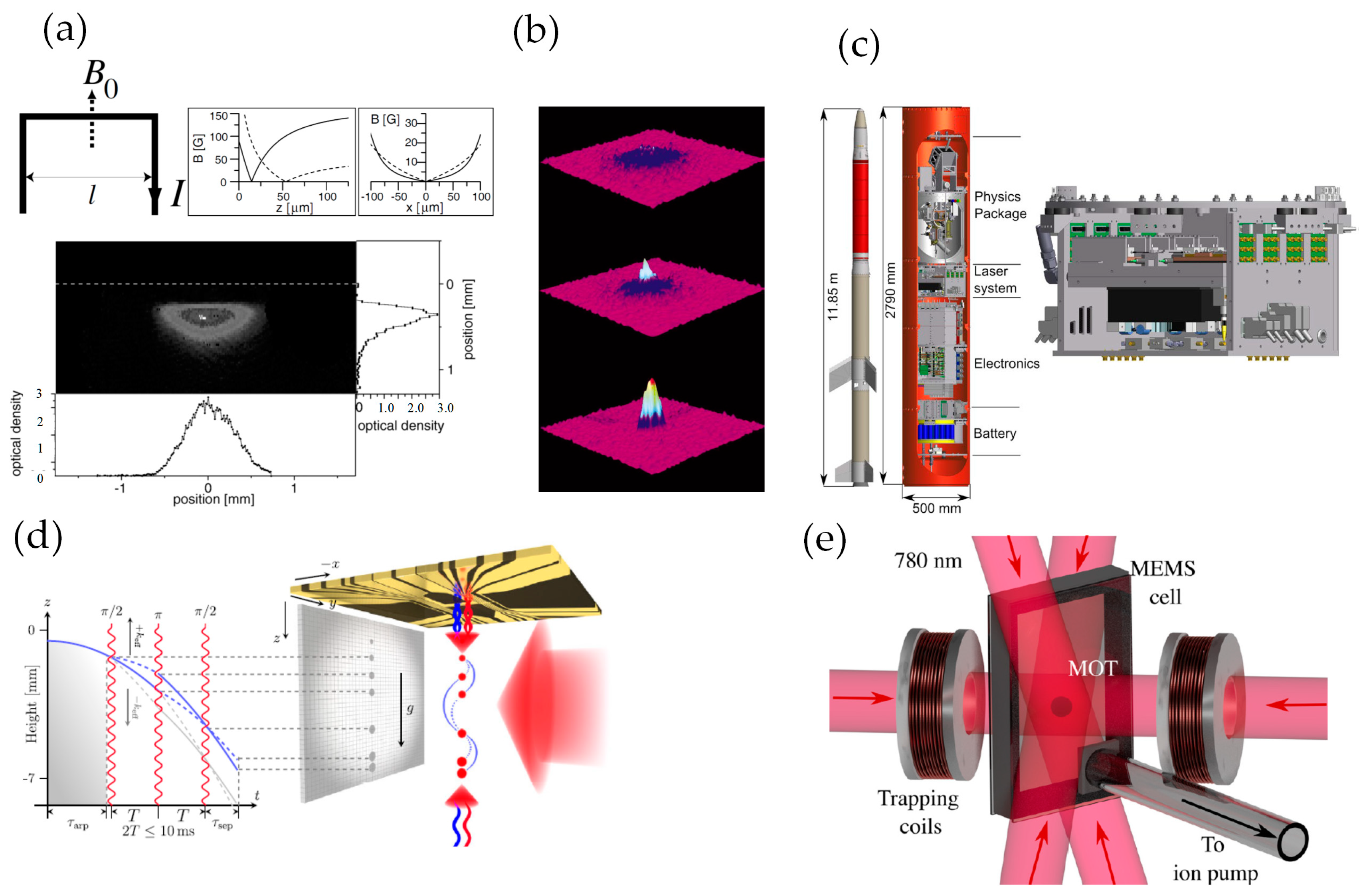

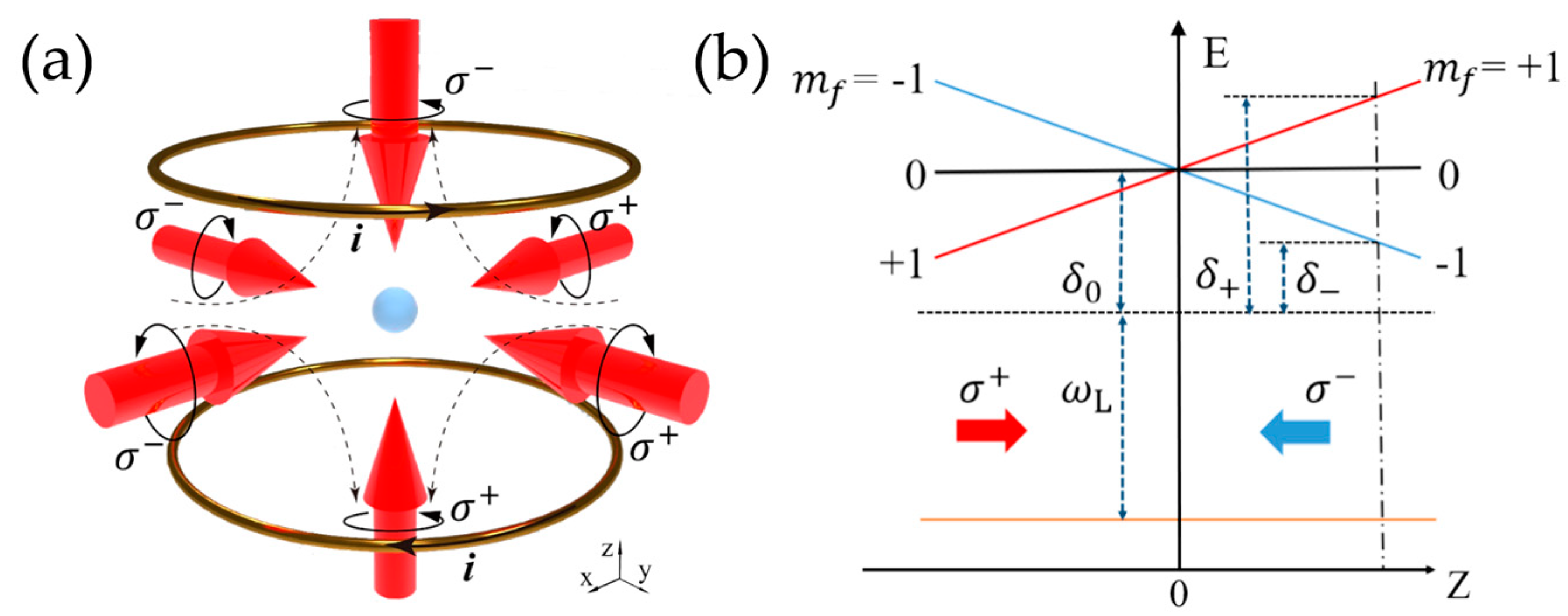
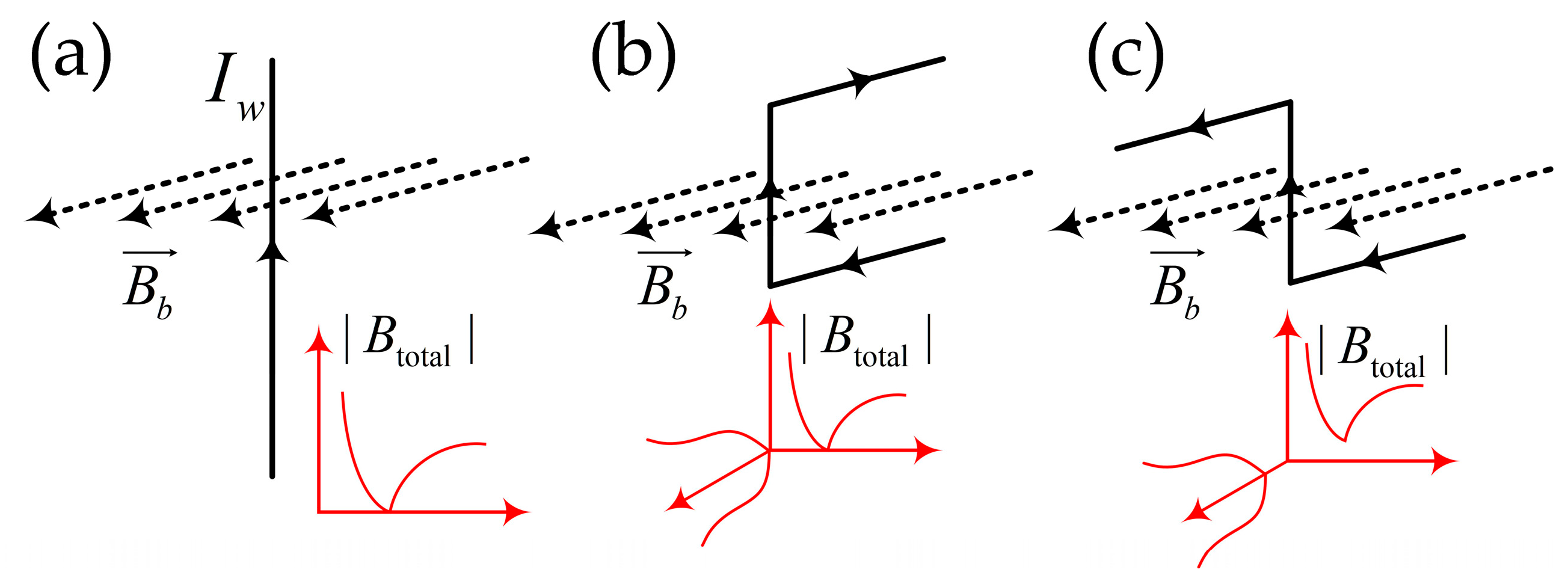

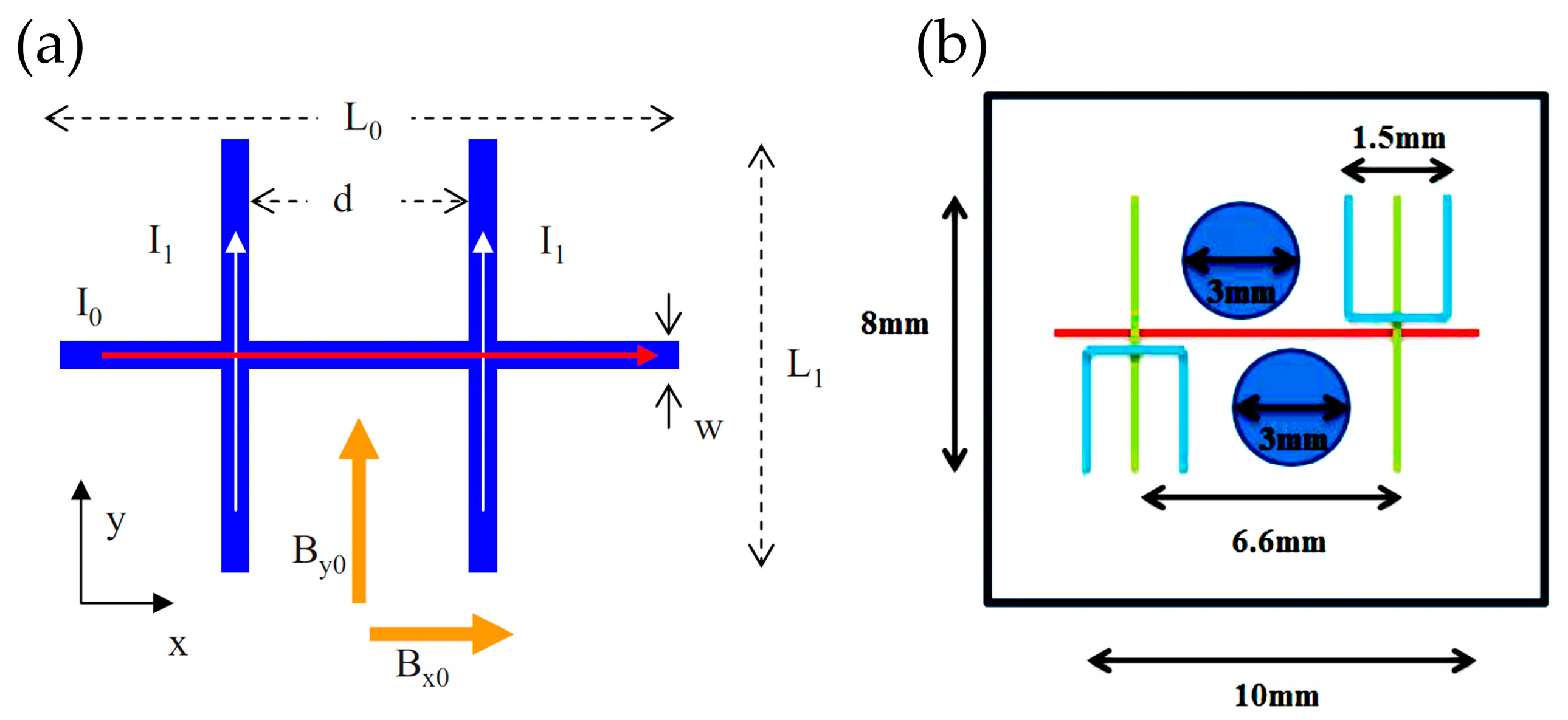
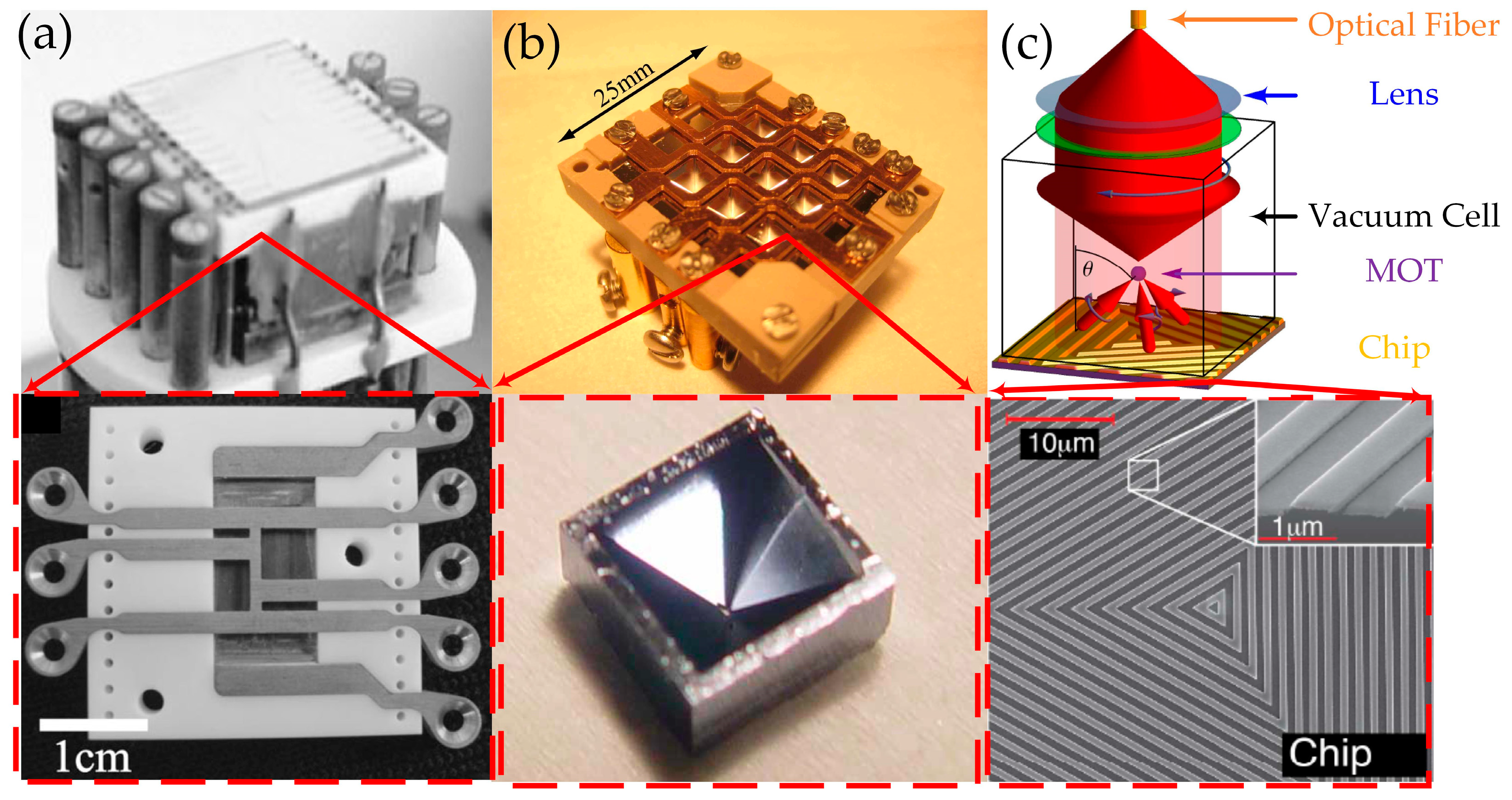

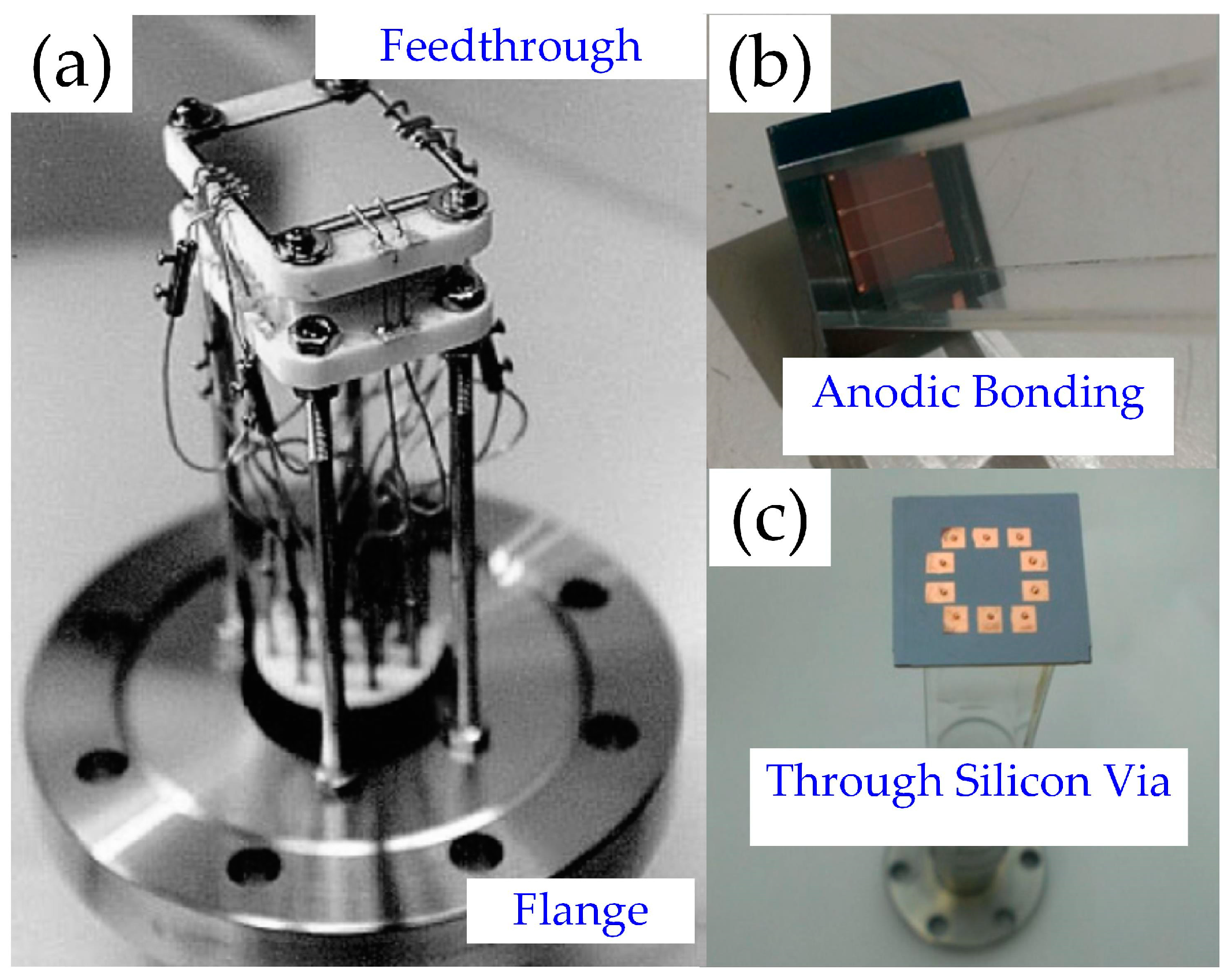
| Research Group | Uncertainty (μGal) | Ref. | |
|---|---|---|---|
| Stanford Uni. | 8 | 3.0 | [38,39,40] |
| Humboldt Uni. | 9.6 | 3.2 | [19] |
| SYRTE | 5.6 | 1.3 | [25,26,41] |
| HUST | 4.2 | 3.0 | [27,42] |
| Substrate Material | Chip Function | Thickness (μm) | Thermal Conductivity (Wm−1K−1) | Transparent or Not | Ref. |
|---|---|---|---|---|---|
| Silicon (Si) | Double layer micro-magnetic trap | 500 | 148 | No | [68] |
| Silicon carbide (SiC) | Micro-magnetic trap | 414 | >390 | Yes | [105] |
| Aluminum nitride (AlN) | Micro-magnetic trap | 600 | 128 | No | [106] |
| Glass (BK7) | Micro-magnetic trap and Mirror | 400 | ~1 | Yes | [69] |
Disclaimer/Publisher’s Note: The statements, opinions and data contained in all publications are solely those of the individual author(s) and contributor(s) and not of MDPI and/or the editor(s). MDPI and/or the editor(s) disclaim responsibility for any injury to people or property resulting from any ideas, methods, instructions or products referred to in the content. |
© 2023 by the authors. Licensee MDPI, Basel, Switzerland. This article is an open access article distributed under the terms and conditions of the Creative Commons Attribution (CC BY) license (https://creativecommons.org/licenses/by/4.0/).
Share and Cite
Li, D.; He, W.; Shi, S.; Wu, B.; Xiao, Y.; Lin, Q.; Li, L. Review of Atom Chips for Absolute Gravity Sensors. Sensors 2023, 23, 5089. https://doi.org/10.3390/s23115089
Li D, He W, Shi S, Wu B, Xiao Y, Lin Q, Li L. Review of Atom Chips for Absolute Gravity Sensors. Sensors. 2023; 23(11):5089. https://doi.org/10.3390/s23115089
Chicago/Turabian StyleLi, Dezhao, Wenfeng He, Shengnan Shi, Bin Wu, Yuhua Xiao, Qiang Lin, and Long Li. 2023. "Review of Atom Chips for Absolute Gravity Sensors" Sensors 23, no. 11: 5089. https://doi.org/10.3390/s23115089





